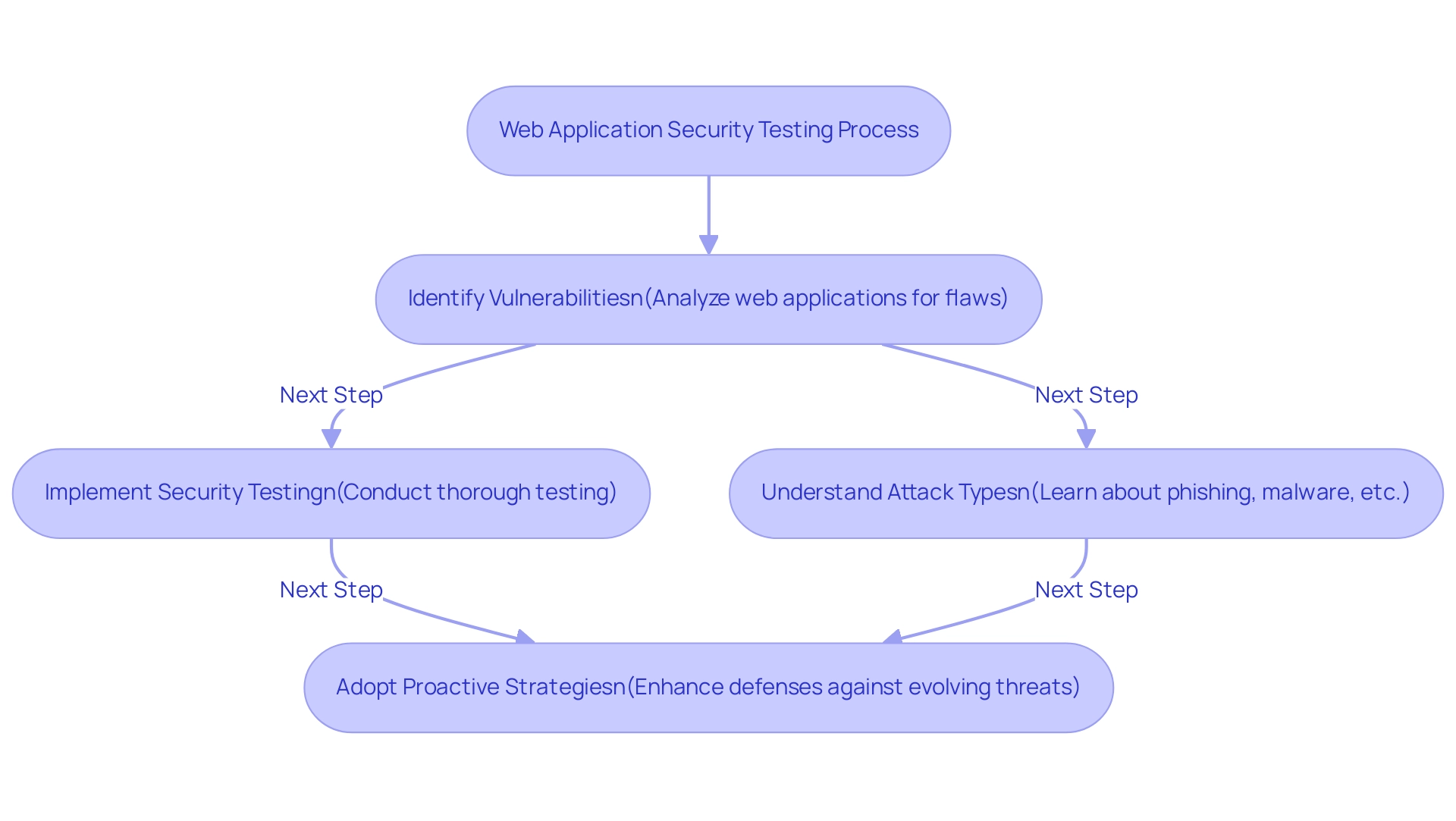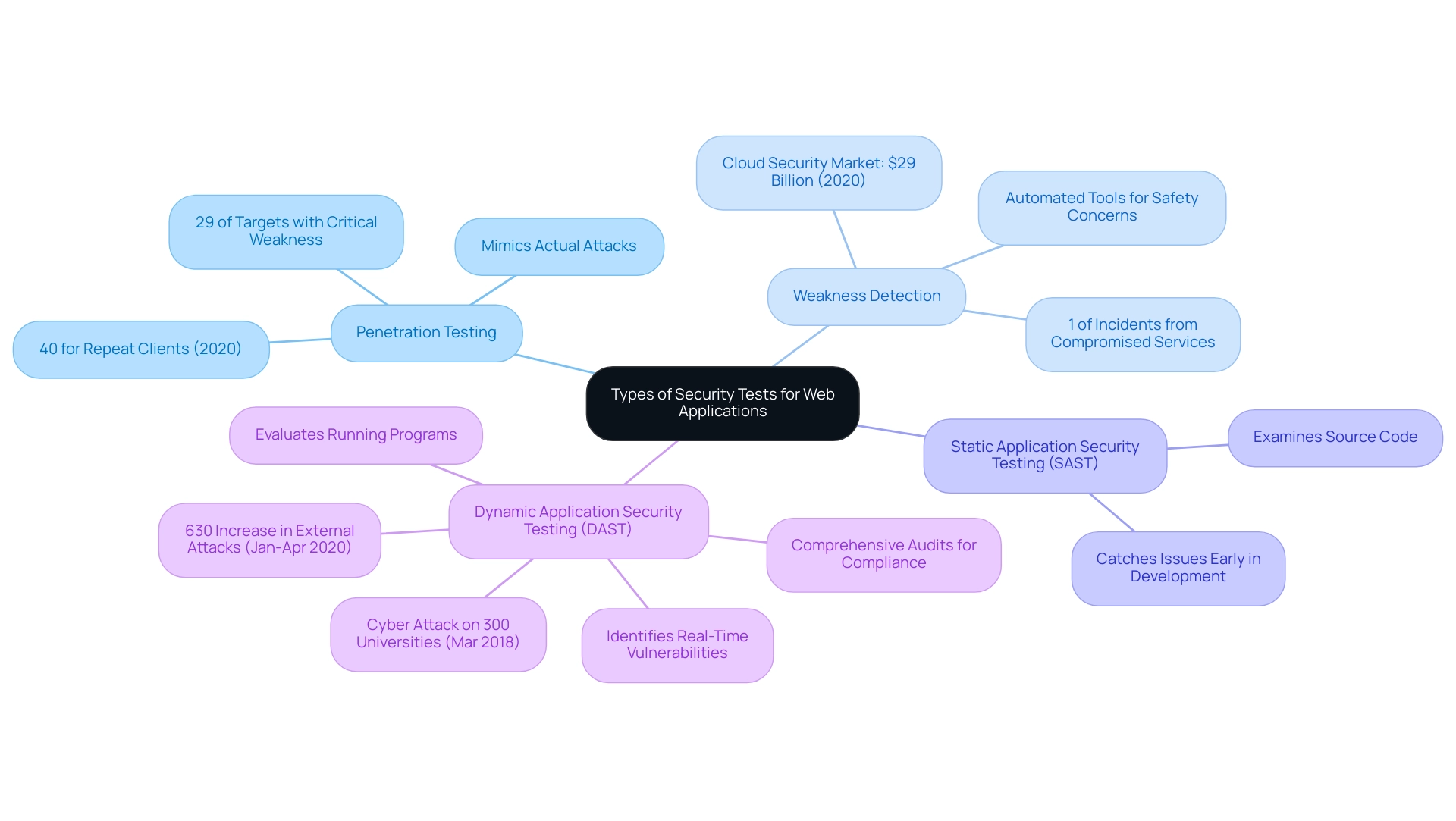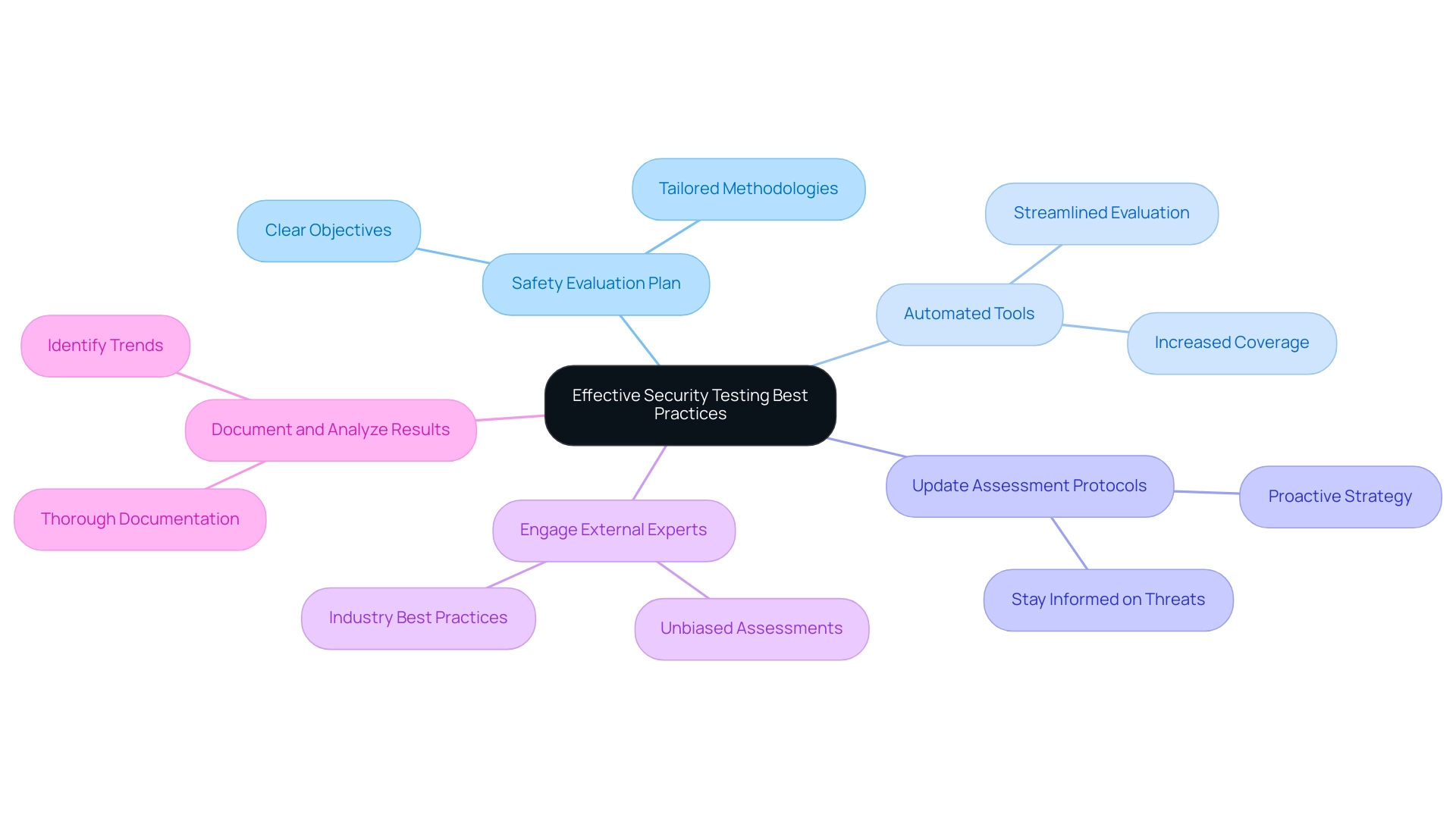Introduction
In an age where digital threats loom larger than ever, the security of web applications has emerged as a critical concern for organizations across various sectors. With e-commerce platforms handling sensitive user data and facing an alarming rise in cyber incidents, the need for comprehensive security testing cannot be overstated.
Recent statistics reveal a staggering number of ransomware attacks, alongside vulnerabilities in medical devices, underscoring the pervasive nature of these risks. By implementing robust security testing strategies, businesses not only protect their assets but also foster customer trust and ensure compliance with stringent regulations.
As the landscape of cyber threats continues to evolve, understanding the different types of security tests available and integrating them into the development lifecycle becomes paramount for safeguarding web applications against potential breaches.
This article delves into the essential practices and methodologies that organizations can adopt to enhance their security posture and navigate the complexities of today’s digital environment.
Understanding Web Application Security Testing
Security testing web applications is crucial for detecting flaws, weaknesses, and threats inherent to web platforms, especially in the e-commerce sector where sensitive information is involved. Recent trends reveal a concerning landscape, with approximately 5,600 ransomware incidents reported between January 2023 and February 2024, highlighting the urgent need for strong protective measures. Alarmingly, medical devices have an average of 6.2 cybersecurity vulnerabilities each, illustrating that vulnerabilities are pervasive across multiple industries.
Organizations that effectively implement security testing web applications not only protect user data but also build customer trust and ensure compliance with regulatory standards. According to IBM, those that harness AI and automation tools can identify and contain breaches an impressive 28 days faster than their counterparts. This capability highlights the necessity of integrating advanced technologies into protection protocols.
Moreover, the frequency of cyber threats, including different attack forms like phishing, malware, and DDoS assaults, requires a thorough comprehension of web system protection. Notably, 43% of spoofing attacks have impersonated Microsoft, emphasizing the sophistication of current threats. The diverse nature of these threats is further illustrated by cybercrime statistics, which show that understanding the various attack types is crucial for developing effective defenses.
By adopting proactive security testing web applications strategies, e-commerce businesses can significantly reduce risks and protect their assets against the evolving cyber threat landscape.

Types of Security Tests for Web Applications
To effectively safeguard web applications, organizations should implement a multifaceted approach that includes security testing web applications by employing various types of security tests. Here are the essential categories:
- Penetration Testing: This approach mimics actual attacks, enabling organizations to discover weaknesses within their systems and assess the effectiveness of their existing defenses.
Significantly, in 2020, a staggering 40% of penetration tests were performed for repeat clients, emphasizing the ongoing need for vigilance, especially as 29% of targets had at least one critical weakness. This statistic underscores the necessity of regular penetration testing to address potential weaknesses proactively.
- Weakness Detection: Employing automated tools, weakness detection systematically examines applications for known safety concerns.
This proactive measure is crucial as the cloud security software market reached $29 billion in 2020, reflecting the increasing focus on security testing web applications and securing web resources. Furthermore, with compromised services representing 1% of all incidents, the importance of identifying weaknesses early cannot be overstated.
- Static Application Security Testing (SAST): SAST entails examining source code for weaknesses without executing the program.
This approach is beneficial for catching issues early in the development lifecycle, thereby reducing potential risks before deployment.
- Dynamic Application Security Testing (DAST): DAST evaluates programs in their running state, identifying vulnerabilities that may not be evident in the static code. This method ensures that the system's real-time performance is also secure against potential exploits.
Comprehensive audits of policies and practices help ensure compliance with industry standards and regulations. Considering the concerning rise in external assaults on cloud accounts by 630% from January to April 2020, and remembering the significant cyber assault on more than 300 universities in March 2018, these audits are essential for organizations to enhance their defensive stance against advancing cyber dangers.
By integrating a mix of these evaluation methodologies, businesses can implement a strong protective strategy that effectively reduces various potential risks through security testing web applications, ensuring the integrity and safety of their web platforms.

Integrating Security Testing into the Development Lifecycle
Incorporating risk assessment into the development lifecycle is essential for security testing web applications, reducing weaknesses, and improving overall application protection. This approach, often referred to as DevSecOps, highlights a smooth partnership between development, protection, and operations teams during every stage—from design and development to deployment and maintenance. Essential activities that organizations ought to adopt consist of:
- Shift Left Evaluation: By emphasizing protective assessments earlier in the development process, teams can discover and resolve weaknesses before they worsen, greatly lowering the chances of problems after deployment. Experts emphasize that shift left testing not only enhances vulnerability detection rates but also fosters a proactive culture of protection within the organization.
- Continuous Integration/Continuous Deployment (CI/CD): Automating assessments within the CI/CD pipeline ensures that evaluations are part of the regular workflow, allowing for ongoing vigilance against potential threats. Current statistics indicate that 72% of organizations are integrating protection with observability and monitoring to tackle dynamic challenges. Moreover, with the adoption of Kubernetes by over 50% of Fortune 100 companies, organizations can utilize this container orchestration platform to improve automation and resilience in their DevSecOps workflows.
- Regular Code Reviews: Fostering a culture of awareness through systematic checks in code reviews can strengthen resilience against breaches. As companies increasingly adopt these practices, a staggering 96% of organizations acknowledge that automating protection and compliance processes can yield significant benefits, underscoring the importance of integrating automation into protocols.
Incorporating these practices not only enhances defense posture but can also lead to substantial cost savings. For example, CloudZero's innovative method for managing cloud costs has allowed companies such as Drift to save $2.4 million each year on AWS expenses, showcasing the financial benefits of strong protective measures. Furthermore, it is essential to mention that 50% of companies indicate that it takes from hours to weeks to fulfill the average access request, emphasizing the need for streamlined processes.
By incorporating security testing web applications at every stage, organizations can effectively reduce the likelihood of vulnerabilities and incidents, paving the way for a safe and efficient development process.

Proven Best Practices for Effective Security Testing
To carry out efficient safety evaluations, organizations should adopt the following best practices:
-
Create a Safety Evaluation Plan: Establish clear objectives, scope, and methodologies tailored to your web application. This essential step is vital for ensuring that the evaluation process aligns with specific safety objectives.
-
Utilize Automated Tools: Leverage automated assessment tools to streamline the evaluation procedure, significantly increasing coverage and efficiency. The use of such tools is becoming increasingly prevalent, with a growing number of organizations recognizing their value in identifying vulnerabilities swiftly.
-
Regularly Update Assessment Protocols: Stay informed about emerging threats and continuously update your assessment protocols to address new vulnerabilities effectively. This proactive strategy is crucial in an environment where cyber threats are continuously changing.
-
Engage External Experts: Collaborate with third-party professionals to gain unbiased assessments and insights into industry best practices. External assessments can reveal possible shortcomings that internal groups might miss.
-
Document and Analyze Results: Maintain thorough documentation of evaluation processes and results to identify trends and areas for improvement. This practice not only assists in monitoring progress but also in improving protective measures over time.
Integrating these best practices can greatly strengthen security testing web applications. For example, organizations that have established organized evaluation strategies have reported enhanced protective measures, effectively shielding sensitive information from possible cyber threats by implementing security testing web applications. The OWASP Foundation, which has tens of thousands of members, emphasizes the significance of security testing web applications in enhancing software protection.
As Vasylyna Khasanova, a QA Engineer, highlights, by recognizing typical vulnerabilities, following an organized testing checklist, using the appropriate tools, and adhering to best practices, developers along with QA engineers can greatly enhance security testing web applications, thereby safeguarding both the system and its users from potential threats. Furthermore, ensuring consistent and compatible encryption protocols across all platforms—web applications, mobile apps, and API integrations—remains a critical aspect of a comprehensive protection strategy. Validating multi-platform consistency ensures that encryption protocols and decryption processes are consistent and compatible across all platforms.
A relevant case study titled 'Safeguarding Sensitive Data in Web Applications' illustrates the importance of security testing web applications, showcasing strategies for protecting sensitive data from potential cyber attacks and resulting in improved security measures.

Conclusion
As the digital landscape continues to evolve, the importance of web application security testing cannot be overstated. Organizations must proactively identify and address vulnerabilities to protect sensitive data, particularly in sectors like e-commerce and healthcare, where the stakes are high. By employing a multifaceted approach that includes various types of security tests—such as penetration testing, vulnerability scanning, and both static and dynamic application security testing—businesses can fortify their defenses against an array of cyber threats.
Integrating security testing into the development lifecycle through practices like DevSecOps ensures that security is prioritized from the outset. By adopting strategies such as shift left testing and continuous integration, organizations can detect vulnerabilities early, reducing the risk of costly breaches post-deployment. The commitment to regular code reviews and automation not only enhances security posture but also promotes a culture of vigilance within teams.
Incorporating proven best practices is essential for effective security testing. Developing a comprehensive security testing plan, utilizing automated tools, and engaging external experts can significantly bolster an organization’s ability to safeguard its assets. Through diligent documentation and continuous adaptation to emerging threats, businesses can stay ahead of potential risks.
Ultimately, fostering a proactive security culture is vital in today’s rapidly changing cyber landscape. By prioritizing web application security and implementing robust testing strategies, organizations not only protect their assets but also build trust with their customers, ensuring compliance with regulatory standards and fortifying their position in the market.





